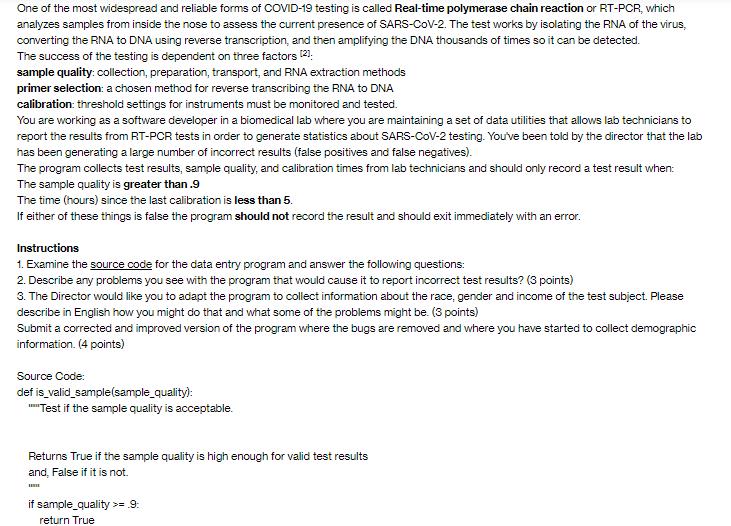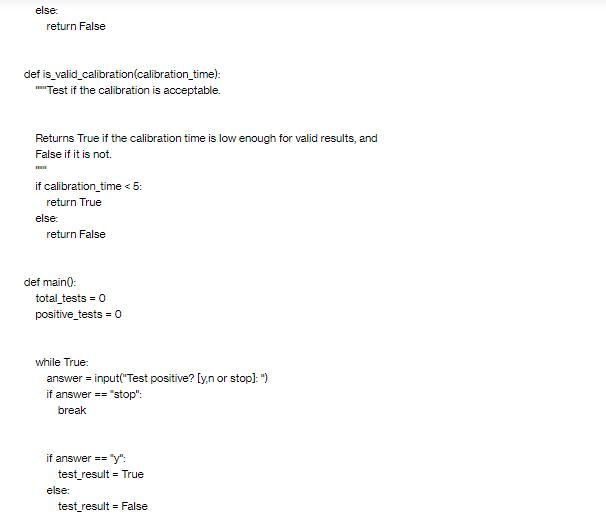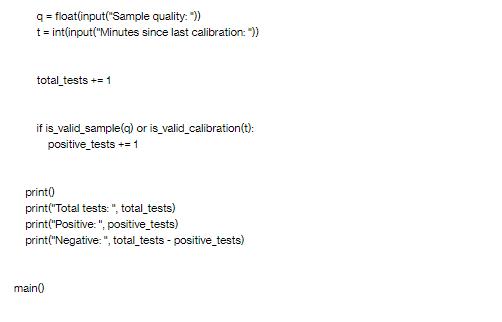Answered step by step
Verified Expert Solution
Question
1 Approved Answer
One of the most widespread and reliable forms of COVID-19 testing is called Real-time polymerase chain reaction or RT-PCR, which analyzes samples from inside



One of the most widespread and reliable forms of COVID-19 testing is called Real-time polymerase chain reaction or RT-PCR, which analyzes samples from inside the nose to assess the current presence of SARS-CoV-2. The test works by isolating the RNA of the virus, converting the RNA to DNA using reverse transcription, and then amplifying the DNA thousands of times so it can be detected. The success of the testing is dependent on three factors [2]. sample quality: collection, preparation, transport, and RNA extraction methods primer selection: a chosen method for reverse transcribing the RNA to DNA calibration: threshold settings for instruments must be monitored and tested. You are working as a software developer in a biomedical lab where you are maintaining a set of data utilities that allows lab technicians to report the results from RT-PCR tests in order to generate statistics about SARS-CoV-2 testing. You've been told by the director that the lab has been generating a large number of incorrect results (false positives and false negatives). The program collects test results, sample quality, and calibration times from lab technicians and should only record a test result when: The sample quality is greater than .9 The time (hours) since the last calibration is less than 5. If either of these things is false the program should not record the result and should exit immediately with an error. Instructions 1. Examine the source code for the data entry program and answer the following questions: 2. Describe any problems you see with the program that would cause it to report incorrect test results? (3 points) 3. The Director would like you to adapt the program to collect information about the race, gender and income of the test subject. Please describe in English how you might do that and what some of the problems might be. (3 points) Submit a corrected and improved version of the program where the bugs are removed and where you have started to collect demographic information. (4 points) Source Code: def is_valid_sample(sample_quality): Test if the sample quality is acceptable. Returns True if the sample quality is high enough for valid test results and, False if it is not. if sample_quality >= .9: return True else: return False def is_valid_calibration(calibration_time): Test if the calibration is acceptable. Returns True if the calibration time is low enough for valid results, and False if it is not. **** if calibration_time < 5: return True else: return False def main(): total_tests = 0 positive tests = 0 while True: answer = input("Test positive? [y/n or stop]: ") if answer == "stop": break if answer="y": test result = True else: test result = False q= float(input("Sample quality: ")) t = int(input("Minutes since last calibration: ")) total_tests += 1 if is_valid_sample(q) or is_valid_calibration(t): positive tests += 1 print() print("Total tests: ", total_tests) print("Positive: ", positive_tests) print("Negative: ", total_tests - positive_tests) main()
Step by Step Solution
There are 3 Steps involved in it
Step: 1
Heres the corrected and improved version of the program python def isvalidsamplesamplequality Test i...
Get Instant Access to Expert-Tailored Solutions
See step-by-step solutions with expert insights and AI powered tools for academic success
Step: 2

Step: 3

Ace Your Homework with AI
Get the answers you need in no time with our AI-driven, step-by-step assistance
Get Started


